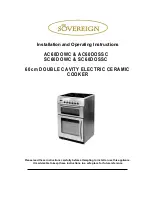
6
Tips for Slow Cooking
• Crock should be at least half-filled for
best results. If only half-filled, check
for doneness 1 to 2 hours earlier
than recipe time.
• Stirring is not necessary when slow
cooking. Removing Lid results in
heat loss and cooking time may
need to be extended. However, if
cooking on HIGH, you may want to
stir occasionally.
• If cooking soups or stews, leave a
2-inch (5-cm) space between top
of Crock and food so that the recipe
can come to a simmer.
• Many recipes call for cooking all day.
If your morning schedule doesn’t
allow time to prepare a recipe, do it
the night before. Place all ingredients
in Crock, cover with Lid, and
refrigerate overnight. In the morning,
simply place Crock in Slow Cooker.
• Some foods are not suited for
extended cooking in a Slow Cooker.
Pasta, seafood, milk, cream, or sour
cream should be added 2 hours
before serving. Evaporated milk or
condensed soups are perfect for
slow cooking.
• The higher the fat content of meat,
the less liquid is needed. If cooking
meat with a high fat content, place
thick onion slices underneath so
meat will not sit on (and cook in) fat.
• Slow Cookers allow for very little
evaporation. If making your favorite
soup, stew, or sauce, reduce liquid
called for in original recipe. If too
thick, liquid can be added later.
• If cooking a vegetable-type
casserole, there will need to be
liquid in the recipe to prevent
scorching on the sides of Crock.
• If cooking a recipe with root
vegetables, place root vegetables in
bottom of Crock.
Two Ways to Slow Cook:
1.
Traditional slow cooking with food
cooking in the 6 qt Crock in Base.
OR
2.
Double Dish slow cooking for
cooking 2 different recipes at
the same time. Always add 2 to
3 cups water to the 6 qt Crock
before adding food to the Double
Dish Vessels, then add Vessels
to Crock. Using more water than
required will cause Double Dish
Vessels to float, and may not cook
food. Reduce water in Crock to
prevent Double Dish Vessels from
floating.







































